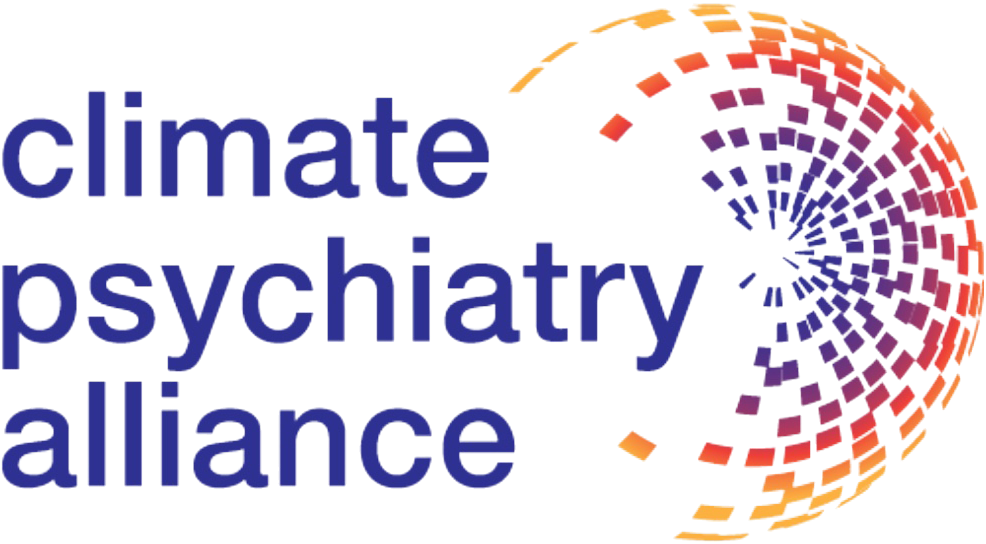Climate Psychiatry 101
Climate Change and Mental Health
“The effects of climate change are like the tossing of a pebble in the pond – the ripples Keep going.”
– Beth Mark, MD, MES
Climate change is one of the most significant threats to health worldwide, and the current and future effects of climate change on mental health are both underappreciated and under-studied.
This overview identifies five major areas in which climate disruption and mental health intersect.
1) Major Disaster Impacts
2) Psychological Factors Related to Threat of Climate Disruption
3) Environmental Impacts
4) Social Determinants & Vulnerable-Population Factors
5) Responses in Psychiatry
Climate change contributes to extreme events of heat waves, severe storms, floods and wildfires. These are expected to increase and can be grouped in acute and slow-moving (chronic) effects:
Acute Impacts of Major Disasters
Direct Heat Effects for Mentally Ill & Mental Health
Increase aggression/conflict: One standard deviation of temperature increase leads to 4% increase in interpersonal violence — especially intimate partner violence with increased impact on women and 14% increase in group violence (Burke et al., 2015).
Increases of 2 to 10 degrees due to “urban heat islands” caused by asphalt and concrete structures and limited green space compared to adjacent suburban and rural communities may be contributor to increased summer violence in inner cities.
Increase Emergency Room and Hospitalization for patients with preexisting psychiatric illness during heat wave (Wang et al., 2014, Hansen et al., 2008).
Double the rate of heat-related deaths during heat waves for patients with pre-existing psychiatric illness (Bark, 1998).
Psychiatric Medications (anti-psychotic, anti-cholinergic and anti-depressants) impair body’s heat regulatory functioning and lithium impact fluid homeostasis (Matin-Latry et al., 2007).
Suicide rates reported increased during extreme heat (Page et al., 2007).
Severe storms/Wildfires/Floods:
Responses range from time-limited distress to severe, anxiety, PTSD, depression and suicidality (Anberg et al., 2013; Fullerton et al., 2013; North et al., 2004; Kessler et al., 2008).
Severe impacts with loss of life, death to family/friends, interruption or loss of employment property loss, loss of housing, displacement and migrations from community, food and clean water scarcity, breakdown of social infrastructure, loss of community and social supports have serious implications for mental health (Berry et al., 2010).
Increase in interpersonal violence following trauma of major extreme weather events with increased risk for women (Harville et al., 2011).
Increase high risk coping behavior with increase alcohol and drug abuse (Flory et al., 2009; Rohrbach et al., 2009).
Slow-Moving Disasters
Prolonged droughts: Increased incidence of suicide in farmers with loss of livelihood, food and clean water scarcity, forced displacement and migrations (Hanigan et al., 2012).
Suicide epidemic among farmers in drought areas of India during growing season (Carleton et al., 2017).
Sea level rise: Serious consequences for survival of coastal communities with implication for mitigation, adaptation or displacement. First “climate refugees” in North America in Alaska, Northern Canada and Louisiana Bayou (Mooney, 2015; Semuels, 2015; Zanolli, 2016).
Impacts of displacements with climate refugees and mass migrations: Wide ranging impacts of fragmented social cohesion, weakened political institutions, violence and potential threat to national security (McMichael & McMichael, 2012; Torres & Casey, 2017).
Psychological factors related to threat of climate disruptions
Emotional impacts range from anxiety, depression and sense of being overwhelmed to denial, disavowal and avoidance with implications for decision-making and behavioral responses (Weintrobe, 2013; Randall, 2005).
Stress Responses due to perceived threats of climate change. Media and popular culture representations of climate change influence stress responses, mental health and sense of well-being (Dodgen, US Global Change Research Program, 2016).
Solastalgia is new term recognizing the existential grief and psychic distress when one’s homeland had been impacted by environmental change (Albrecht et al., 2007).
Additional impacts of denial and disavowal exist at an individual, community and societal level leading to ineffective or outright dangerous policy decisions, (even reversals of efforts to mitigate or prevent ongoing and impending effects of climate change) (Devine-Wright, 2013).
Threats to secure child psychological development: There are a range of possible impacts on psychological development of children growing up in world with exposure to existential threats (area for research).
Environmental Impacts
Air-pollution: Neurotoxic effects of particulate matter exposure linked to impaired cognition and memory, accelerated dementia, brain atrophy, higher rates of strokes and other neuro-degenerative processes in adults.
Children and young adults are particularly vulnerable to air-pollutant effects with links to ADHD, impaired cognitive development and autism. Prenatal exposure to air pollution is particularly harmful to fetal brain development. (Calderón-Garcidueñas et al., 2014; Brockmeyer & D’Anguilli, 2016; Scram, 2017)
Social determinants & vulnerable populations
Populations at Greatest Risk: Poor populations, minority communities, people of color, immigrants and migrants, homeless, medically disabled including mentally ill and substance users. Women, especially pregnant and postpartum women, and children are at increased risk for negative effects. All impacts multiplied by social determinants of health. The added burden of the higher incidence of poverty, poor community infrastructure, substandard housing or homelessness, and the coincidence of substance abuse all contribute to amplifying the risks for the mentally ill (Gambles et al., 2016).
Vulnerable Nations and International Impacts: Most nations vulnerable to impacts of climate change are under-developed or developing countries with greatest exposure to the impacts of extreme heat, sea level rise, major storms and flooding coupled with poor infrastructure and fragile political and social institutions
Climate Change Vulnerability Index
Notre Dame Global Adaptation Initiative
Responses in psychiatry: sustainability/adaptation & mitigation/resiliency
Research agenda identification for the new field of climate psychiatry
Educational initiatives in medical schools and residencies


